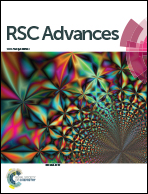ZnO quantum dot-modified rGO with enhanced electrochemical performance for lithium–sulfur batteries†
Abstract
Lithium–sulfur batteries are considered the most promising next-generation energy storage devices. However, problems like sluggish reaction kinetics and severe shuttle effect need to be solved before the commercialization of Li–S batteries. Here, we successfully prepared ZnO quantum dot-modified reduced graphene oxide (rGO@ZnO QDs), and first introduced it into Li–S cathodes (rGO@ZnO QDs/S). Due to its merits of a catalysis effect and enhancing the reaction kinetics, low surface impedance, and efficient adsorption of polysulfide, rGO@ZnO QDs/S presented excellent rate capacity with clear discharge plateaus even at a high rate of 4C, and superb cycle performance. An initial discharge capacity of 998.8 mA h g−1 was delivered, of which 73.3% was retained after 400 cycles at a high rate of 1C. This work provides a new concept to introduce quantum dots into lithium–sulfur cathodes to realize better electrochemical performance.



 Please wait while we load your content...
Please wait while we load your content...